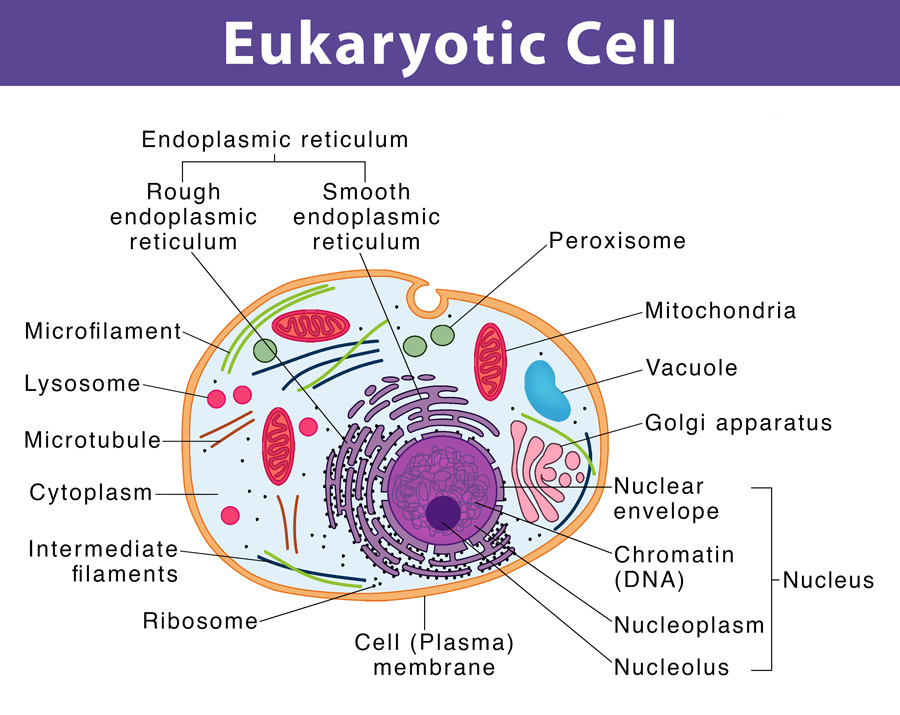1.5 – EUKARYOTIC CELL STRUCTURE AND FUNCTION
| 10 Students |
| Grade 11-12 |
COURSE DESCRIPTION
This concept discusses the typical cell model of prokaryotes and eukaryotes, including plants and animals. A strong understanding of the structure of the following organelles and cellular structures in relation to their function is necessary: rough and smooth endoplasmic reticulum, Golgi body, mitochondria, ribosomes, lysosomes, chloroplasts, cell surface membrane, nuclear envelope, centrioles, nucleus and nucleolus.
Learning Outcome:
- Outline the cell theory with the understanding that cells are the smallest unit of life, all cells come from pre-existing cells and living organisms are composed of cells.
- Interpret and recognise drawings, photomicrographs and electronmicrographs of the followings membrane systems and organelles: rough and smooth endoplasmic reticulum, Golgi body, mitochondria, ribosomes, lysosomes, chloroplasts, cell surface membrane, nuclear envelope, centrioles, nucleus and nucleolus. (For practical assessment, students may be required to operate a light microscope, mount slides and use a graticule.)
- Outline the functions of the membrane systems and organelles listed in (b)
- Describe the structure of a typical bacterial cell (small and unicellular, peptidoglycan cell wall, circular DNA, 70S ribosomes and lack of membrane-bound organelles)
Outline:
- The Cell
- Cell Size
- Ultrastructure of the Eukaryotic Cell
- Cytoplasm
- The Organelles
- The Membranous Organelles
- The Non-Membranous Organelles
- The Plasma Membrane
- The Plant Cell Wall
- The Cell Junctions
- The Study of Cells – Cytology
- A sense of scale in the study of cells
- Techniques – Light and Electron Microscopy
- Techniques – Cell Fractionation
- Cell fractionation – Homogenisation
- Cell fractionation – Differential Centrifugation
- Techniques – Autoradiography
Requirements
- Donec porta ultricies urna, faucibus magna dapibus.
- Etiam varius tortor ut ligula facilisis varius in a leo.
- Folutpat tempor tur duis mattis dapibus, felis amet.
- Donec porta ultricies urna, faucibus magna dapibus.
- Etiam varius tortor ut ligula facilisis varius in a leo.
- Folutpat tempor tur duis mattis dapibus, felis amet.
What is the target audience?
- This course is intended for anyone interested in learning to master his or her own body.
- This course is aimed at beginners, so no previous experience with hand balancing skillts is necessary
Aenean viverra tincidunt nibh, in imperdiet nunc. Suspendisse eu ante pretium, consectetur leo at, congue quam. Nullam hendrerit porta ante vitae tristique. Vestibulum ante ipsum primis in faucibus orci luctus et ultrices posuere cubilia Curae; Vestibulum ligula libero, feugiat faucibus mattis eget, pulvinar et ligula.
CURRICULUM
Section 1: Introduction to Handstands
Section 2: Reference Material, Moodboards and Mind Mapping
Wrist Strengthening
While your wrists will certain get stronger from practice and grow accustomed to the stress of the skill, a basic amount of wrist strengthening exercises for several weeks can only help things. I’d recommend working wrist curls and reverse wrist curls for around 6-10 reps for 3 sets. I also strongly recommend trying some sledgehammer levering. Work in 2-3 sets of 3-5 reps. In particular, exercises 1 and 3 are fantastic for building wrist strength and they are much harder than they look! Start with them to get the hang of sledgehammer work before you progress to the other two exercises. I don’t want somebody putting a hole through their floor or their face because they rushed things!Section 3: Sketching out Ideas
- The main objective to the sketching process is to generate super rough thumbnail sketches of what we feel best visually communicates the highlighted words from our mind maps.
- Take as much time as you need for this step — this might be 10 minutes or it might be 10 days.
- Personally, I like to work quickly and try not to analyze or elaborate too much.
- Now, that doesn't mean you should only create a handful of sketches.
- Even though this step only took a couple of hours, I was still able to put over 100 thumbnails on paper.
- The whole point of this process is to flush out the bad ideas and narrow down the good ones until we find that one layout that really speaks to us.
- Also, keep in mind the project brief and have your list in front of you as a reference to avoid getting sidetracked.
- Remember—detail is not needed. Simply flush out the bad ideas and find a great direction.
- Once I feel I have a good direction with the sketches, I'm now ready to take a quick photo with my phone and import it into Illustrator.
Section 4: Conclusions and Evaluation
About Instructors
Reviews
Average Rating
Detailed Rating
| Stars 5 |
|
0 |
| Stars 4 |
|
0 |
| Stars 3 |
|
0 |
| Stars 2 |
|
0 |
| Stars 1 |
|
0 |
Be the first to review “1.5 – EUKARYOTIC CELL STRUCTURE AND FUNCTION” Cancel reply
| 10 Students |
| Grade 11-12 |



There are no reviews yet.